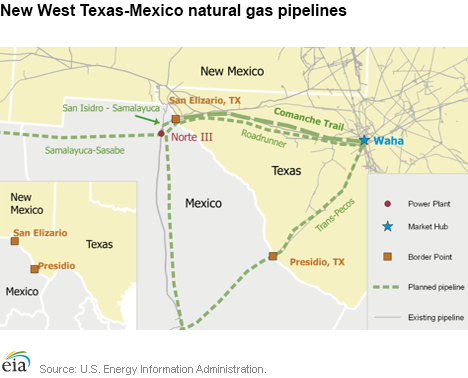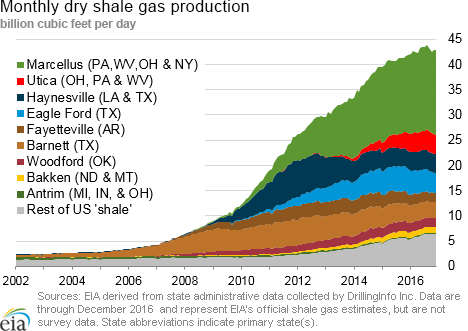In the News:
The San Elizario Border Crossing Project is authorized to commence service
The San Elizario Border Crossing Project, which will provide 1.1 billion cubic feet per day (Bcf/d) of natural gas pipeline capacity from San Elizario, Texas, across the border to San Isidro, Chihuahua, Mexico, was granted in-service approval by the Federal Energy Regulatory Commission on January 27. The crossing consists of 1,086 feet of 42-inch pipe and was installed under the Rio Grande River using horizontal directional drilling. The project is part of the Comanche Trail Pipeline Project, a 195-mile intrastate pipeline connecting the Waha hub in northern Pecos County, Texas, to the Mexican border. This intrastate pipeline, with some delivery points in Texas, is regulated by the Texas Railroad Commission, which is expected to grant in-service approval in early-2017.
From San Isidro, natural gas will be used to meet rising electric power and industrial demand in northern Mexico. Energy Transfer Partners, which will be operating the pipeline in Texas, will deliver natural gas on behalf of Mexico's Comisión Federal de Electricidad (CFE) to the border. CFE has several natural gas infrastructure projects currently under construction. CFE's San Isidro-Samalayuca Pipeline, a 15-mile, 1.135 Bcf/d project, is expected to come into service in early-2017. The pipeline will connect this new border crossing to the 906 megawatt Norte III combined cycle power plant in Samalayuca, another CFE infrastructure project under construction with an expected completion date of November 2017. From there, CFE's 0.472 Bcf/d Samalayuca-Sasabe Pipeline will extend more than 400 miles west into Sonora, Mexico, where it will supply new natural gas-fired power plants as well as replace fuel oil in existing electricity generation units. This pipeline is currently expected to be completed in November 2017.
In addition to the Comanche Trail Pipeline, there are several other projects currently under construction that will connect Permian natural gas to emerging demand centers in Mexico. Energy Transfer Partners is also constructing the Trans-Pecos Pipeline Project, a 1.4 Bcf/d pipeline connecting the Waha hub to the United States-Mexico border at Presidio, Texas. ONEOK Partners is also building the Roadrunner Gas Transmission Pipeline Project, a 200-mile pipeline connecting the WesTex natural gas system in Coyanosa, Texas to Mexico near San Elizario, Texas. The 0.640 Bcf/d pipeline is being constructed in stages. The first stage, providing 0.170 Bcf/d of capacity, was completed in March 2016. The second stage is expected to be completed in early-2017, and the third is projected to be in service in 2019.
Overview:
(For the Week Ending Wednesday, February 1, 2017)
- Natural gas spot prices fell at most locations this report week (Wednesday, January 25 to Wednesday, February 1). The Henry Hub spot price fell from $3.25 per million British thermal units (MMBtu) last Wednesday to $3.12/MMBtu yesterday.
- At the New York Mercantile Exchange (Nymex), the February 2017 contract expired Friday at $3.391/MMBtu. The March 2017 contract decreased to $3.168/MMBtu, down 18¢ Wednesday to Wednesday.
- Net withdrawals from working gas totaled 87 billion cubic feet (Bcf) for the week ending January 27. Working natural gas stocks are 2,711 Bcf, which is 9% less than the year-ago level and 2% greater than the five-year (2012–16) average for this week.
- The natural gas plant liquids composite price at Mont Belvieu, Texas, rose by 4¢, closing at $6.67/MMBtu for the week ending January 27. The prices of natural gasoline and ethane fell by 14% and 12%, respectively. The prices of propane, butane, and isobutane rose by 5%, 13%, and 11%, respectively.
- According to Baker Hughes, for the week ending Friday, January 27, the natural gas rig count increased by 3 to 145. The number of oil-directed rigs rose by 15 to 566. The total rig count climbed by 18, and it now stands at 712.
Prices/Supply/Demand:
Prices fall everywhere outside the Northeast. This report week (Wednesday, January 25 to Wednesday, February 1), the Henry Hub spot price fell 13¢ from $3.25/MMBtu last Wednesday to $3.12/MMBtu yesterday. Temperatures moderated throughout the report week almost everywhere except for in the Northeast. As a result, prices generally fell Wednesday to Wednesday.
At the Chicago Citygate, prices decreased 14¢ from $3.22/MMBtu last Wednesday to $3.08/MMBtu yesterday. Prices at PG&E Citygate in Northern California fell 16¢, down from $3.66/MMBtu last Wednesday to $3.50/MMBtu yesterday.
The price at SoCal Citygate decreased 35¢ from $3.66/MMBtu last Wednesday to $3.31/MMBtu yesterday. On Monday, January 23, SoCalGas issued an advisory asking customers to reduce natural gas consumption as much as possible. Then on Thursday, the advisory, referred to as a curtailment watch, was lifted. During the period, SoCalGas reports that they withdrew from normally operating storage facilities at maximum withdrawal rates, and also withdrew from the Aliso Canyon field. Aliso Canyon's operations are still being reviewed by the California Public Utilities Commission following the leak in late 2015. EIA releases daily Southern California energy market information in its Southern California Daily Energy Report.
Northeast prices up. In contrast to other parts of the nation, the Northeast experienced colder weather toward the end of the report week. At the Algonquin Citygate, which serves Boston-area consumers, prices went up $1.83 from $3.56/MMBtu last Wednesday to $5.39/MMBtu yesterday. At the Transcontinental Pipeline Zone 6 trading point for New York, prices increased 22¢ from $3.18/MMBtu last Wednesday to $3.40/MMBtu yesterday.
In contrast to New York City and Boston prices, Appalachian prices mostly fell. Tennessee Zone 4 Marcellus spot prices decreased 20¢ from $2.95/MMBtu last Wednesday to $2.75/MMBtu yesterday. Prices at Dominion South in northwest Pennsylvania fell 10¢ from $3.00/MMBtu last Wednesday to $2.90/MMBtu yesterday.
February Nymex contract expires up; March contract closes down. At the Nymex, the February 2017 contract expired Friday at $3.391/MMBtu, up 16¢ from last Wednesday. By contrast, the March 2017 contract decreased to $3.168/MMBtu, down 18¢ from last Wednesday to yesterday. The price of the 12-month strip, averaging March 2017 through February 2018 futures contracts, declined 12¢to $3.362/MMBtu.
Supply remains flat. According to data from PointLogic, the average total supply of natural gas remained the same as the previous report week, averaging 76.3 Bcf/d. Dry natural gas production remained constant week over week. Average net imports from Canada decreased by 1% from last week.
Demand rises on colder weather. Total U.S. consumption of natural gas rose by 13% compared with the previous report week, according to data from PointLogic. Although temperatures warmed by the end of the report week, this report week was colder than the previous one, pushing up demand for home heating. Power burn climbed by 4%, industrial sector consumption increased by 4%, and residential and commercial sector consumption increased by 27%. Natural gas exports to Mexico were the same as last week, averaging 4.0 Bcf/d.
U.S. liquefied natural gas (LNG) exports. Natural gas pipeline deliveries to the Sabine Pass liquefaction terminal averaged 1.8 Bcf/d for the report week, unchanged from the previous week. Four vessels (combined LNG-carrying capacity of 14.1 Bcf) departed Sabine Pass last week. In January 2017, 15 LNG cargoes were exported from Sabine Pass, exceeding the previous record set in December 2016 with 12 exported cargoes.
Storage:
Unseasonably mild weather leads to another relatively modest net withdrawal. For the second week in a row, considerably warmer-than-normal temperatures resulted in net withdrawals falling below the five-year average. Net withdrawals from storage totaled 87 Bcf, compared with the five-year (2012–16) average net withdrawal of 166 Bcf and last year's net withdrawals of 169 Bcf during the same week. Warmer-than-normal temperatures throughout most of the Lower 48 states mitigated heating demand for natural gas and contributed to the below-average withdrawals from storage. Working gas stocks totaled 2,711 Bcf, which is 59 Bcf more than the five-year average and 266 Bcf less than last year at this time.
Working gas stocks remain below five-year average in select regions. Despite Lower 48 working gas stocks exceeding the five-year average in total for the first time in 2017, in several regions, stocks remain below their five-year average. The East, Pacifc, and South Central Nonsalt regions are 40, 41, and 13 Bcf below the five-year average, respectively. The Midwest, Mountain, and South Central salt regions are 45 Bcf, 11 Bcf, and 97 Bcf above the five-year average, respectively. The regions east of the Mountain region have gained ground compared with the five-year average in each of the last two weeks, owing to unseasonably mild January weather.
Following strong net withdrawals in December, working gas stocks post relatively small withdrawals in January. The 2016–17 heating season began quickly in December, posting three weeks of net withdrawals topping the 200 Bcf threshold. However, since then net withdrawals have fallen well short of historical norms during January. Net withdrawals in December 2016 totaled 691 Bcf, compared with the five-year average of 453 Bcf over the same period. In contrast, net withdrawals from storage during the January 1–27 period totaled 557 Bcf compared with the five-year average of 601 Bcf over the same period.
Net withdrawals are neutral to market expectations. According to the Bloomberg survey of natural gas analysts, estimates of net natural gas withdrawals from storage generally ranged from 78 Bcf to 98 Bcf, with a median of 83 Bcf. The price of the Nymex futures contract for March 2017 delivery at Henry Hub rose 2¢/MMBtu to $3.15 MMBtu in 340 trades at the release of the Weekly Natural Gas Storage Report (WNGSR).
Warming temperatures are significantly higher than normal. Temperatures in the Lower 48 states averaged 44°F, 11°F higher than the normal and 10°F higher than last year at this time. Temperatures rose 4°F for the week on average in the Lower 48 states. Temperatures in most regions outside the Pacific and Mountain regions were significantly above seasonal norms for the period. Heating degree days (HDD) in the Lower 48 states totaled 151, compared with 219 last year and a normal of 223.
See also:
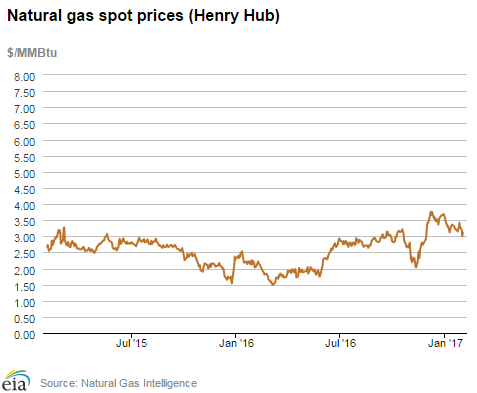
| Spot Prices ($/MMBtu) | Thu, 26-Jan |
Fri, 27-Jan |
Mon, 30-Jan |
Tue, 31-Jan |
Wed, 1-Feb |
|---|---|---|---|---|---|
| Henry Hub | 3.42 |
3.29 |
3.20 |
3.00 |
3.12 |
| New York | 3.37 |
3.58 |
3.34 |
3.01 |
3.40 |
| Chicago | 3.34 |
3.21 |
3.13 |
3.01 |
3.08 |
| Cal. Comp. Avg.* | 3.53 |
3.32 |
3.22 |
3.12 |
3.16 |
| Futures ($/MMBtu) | |||||
| February Contract | 3.382 |
3.391 |
Expired |
Expired |
Expired |
| March Contract | 3.397 |
3.358 |
3.232 |
3.117 |
3.168 |
| April Contract | 3.410 |
3.380 |
3.271 |
3.165 |
3.214 |
| *Avg. of NGI's reported prices for: Malin, PG&E Citygate, and Southern California Border Avg. | |||||
| Source: NGI's Daily Gas Price Index | |||||
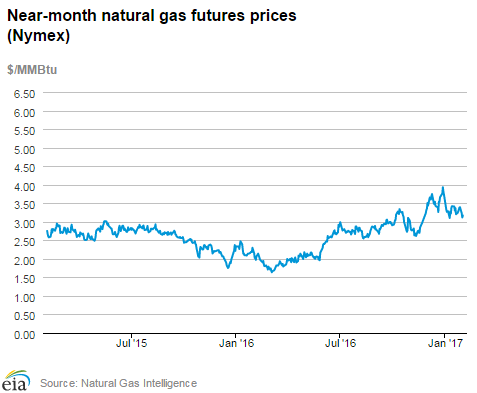
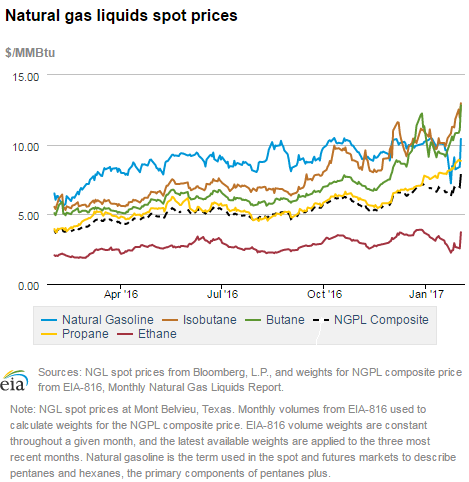
| U.S. natural gas supply - Gas Week: (1/26/17 - 2/1/17) | |||
|---|---|---|---|
Average daily values (Bcf/d): |
|||
this week |
last week |
last year |
|
| Marketed production | 78.9 |
78.9 |
81.4 |
| Dry production | 70.4 |
70.4 |
72.9 |
| Net Canada imports | 5.8 |
5.8 |
5.7 |
| LNG pipeline deliveries | 0.2 |
0.3 |
0.3 |
| Total supply | 76.3 |
76.5 |
79.0 |
|
Source: OPIS PointLogic Energy, an IHS Company | |||
| U.S. natural gas consumption - Gas Week: (1/26/17 - 2/1/17) | |||
|---|---|---|---|
Average daily values (Bcf/d): |
|||
this week |
last week |
last year |
|
| U.S. consumption | 84.3 |
74.3 |
82.0 |
| Power | 21.7 |
20.8 |
23.1 |
| Industrial | 22.7 |
22.0 |
22.2 |
| Residential/commercial | 39.9 |
31.5 |
36.7 |
| Mexico exports | 4.0 |
4.0 |
3.4 |
| Pipeline fuel use/losses | 6.6 |
5.8 |
6.4 |
| LNG pipeline receipts | 1.8 |
2.0 |
0.0 |
| Total demand | 96.7 |
86.1 |
91.8 |
|
Source: OPIS PointLogic Energy, an IHS Company | |||
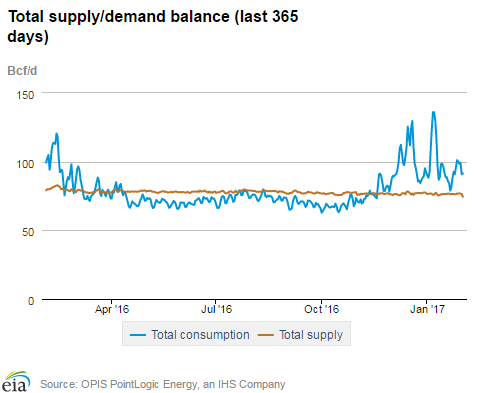
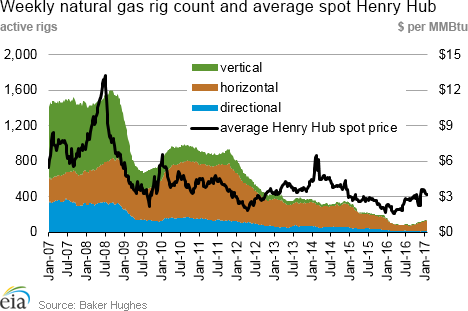
| Rigs | |||
|---|---|---|---|
Fri, January 27, 2017 |
Change from |
||
last week |
last year |
||
| Oil rigs | 566 |
2.7% |
13.7% |
| Natural gas rigs | 145 |
2.1% |
19.8% |
| Miscellaneous | 1 |
0.0% |
0.0% |
| Rig numbers by type | |||
|---|---|---|---|
Fri, January 27, 2017 |
Change from |
||
last week |
last year |
||
| Vertical | 72 |
-4.0% |
-2.7% |
| Horizontal | 579 |
3.6% |
18.9% |
| Directional | 61 |
1.7% |
5.2% |
| Source: Baker Hughes Inc. | |||
| Working gas in underground storage | ||||
|---|---|---|---|---|
Stocks billion cubic feet (Bcf) |
||||
| Region | 2017-01-27 |
2017-01-20 |
change |
|
| East | 569 |
596 |
-27 |
|
| Midwest | 730 |
757 |
-27 |
|
| Mountain | 164 |
173 |
-9 |
|
| Pacific | 221 |
235 |
-14 |
|
| South Central | 1,027 |
1,037 |
-10 |
|
| Total | 2,711 |
2,798 |
-87 |
|
| Source: U.S. Energy Information Administration | ||||
| Working gas in underground storage | |||||
|---|---|---|---|---|---|
Historical comparisons |
|||||
Year ago (1/27/16) |
5-year average (2012-2016) |
||||
| Region | Stocks (Bcf) |
% change |
Stocks (Bcf) |
% change |
|
| East | 656 |
-13.3 |
609 |
-6.6 |
|
| Midwest | 780 |
-6.4 |
685 |
6.6 |
|
| Mountain | 160 |
2.5 |
153 |
7.2 |
|
| Pacific | 272 |
-18.8 |
262 |
-15.6 |
|
| South Central | 1,109 |
-7.4 |
944 |
8.8 |
|
| Total | 2,977 |
-8.9 |
2,652 |
2.2 |
|
| Source: U.S. Energy Information Administration | |||||
| Temperature -- heating & cooling degree days (week ending Jan 26) | ||||||||
|---|---|---|---|---|---|---|---|---|
HDD deviation from: |
CDD deviation from: |
|||||||
| Region | HDD Current |
normal |
last year |
CDD Current |
normal |
last year |
||
| New England | 182 |
-93 |
-91 |
0 |
0 |
0 |
||
| Middle Atlantic | 166 |
-97 |
-112 |
0 |
0 |
0 |
||
| E N Central | 168 |
-127 |
-120 |
0 |
0 |
0 |
||
| W N Central | 205 |
-108 |
-80 |
0 |
0 |
0 |
||
| South Atlantic | 93 |
-88 |
-128 |
12 |
4 |
10 |
||
| E S Central | 85 |
-101 |
-127 |
0 |
-1 |
0 |
||
| W S Central | 65 |
-72 |
-61 |
6 |
2 |
6 |
||
| Mountain | 231 |
3 |
31 |
0 |
-1 |
0 |
||
| Pacific | 148 |
31 |
54 |
0 |
-1 |
0 |
||
| United States | 151 |
-72 |
-68 |
3 |
1 |
3 |
||
|
Note: HDD = heating degree day; CDD = cooling degree day Source: National Oceanic and Atmospheric Administration | ||||||||
Average temperature (°F)
7-Day Mean ending Jan 26, 2017
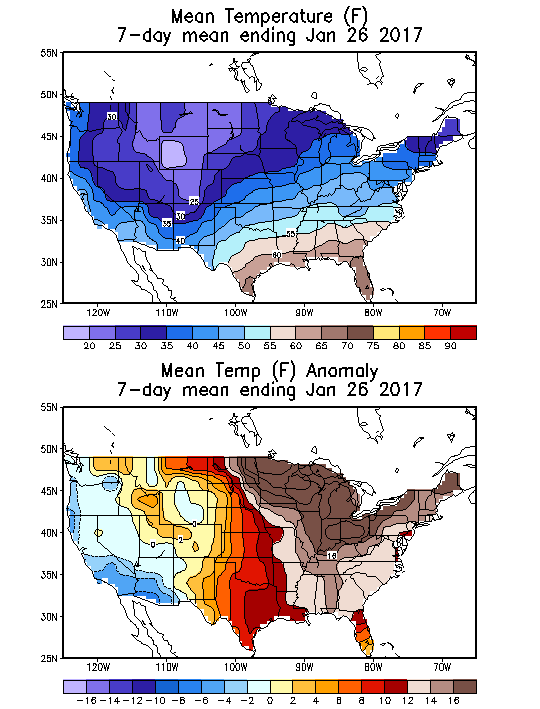
Source: NOAA National Weather Service
Deviation between average and normal (°F)
7-Day Mean ending Jan 26, 2017

Source: NOAA National Weather Service

